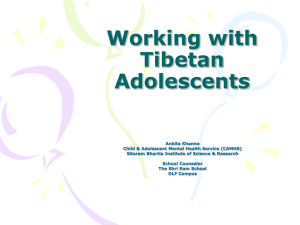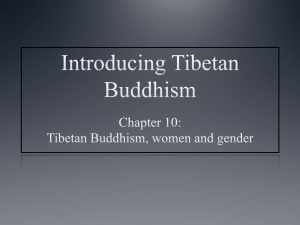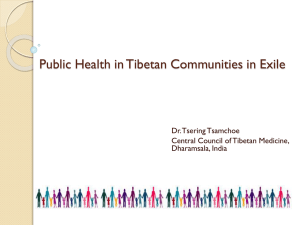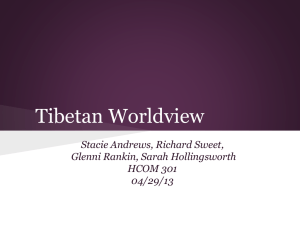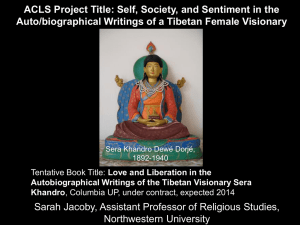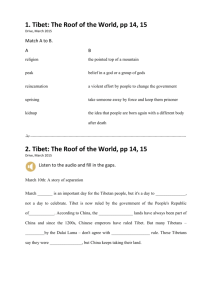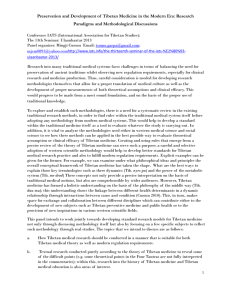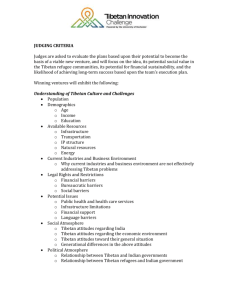International Workshop: Tibetan Borderlands
advertisement
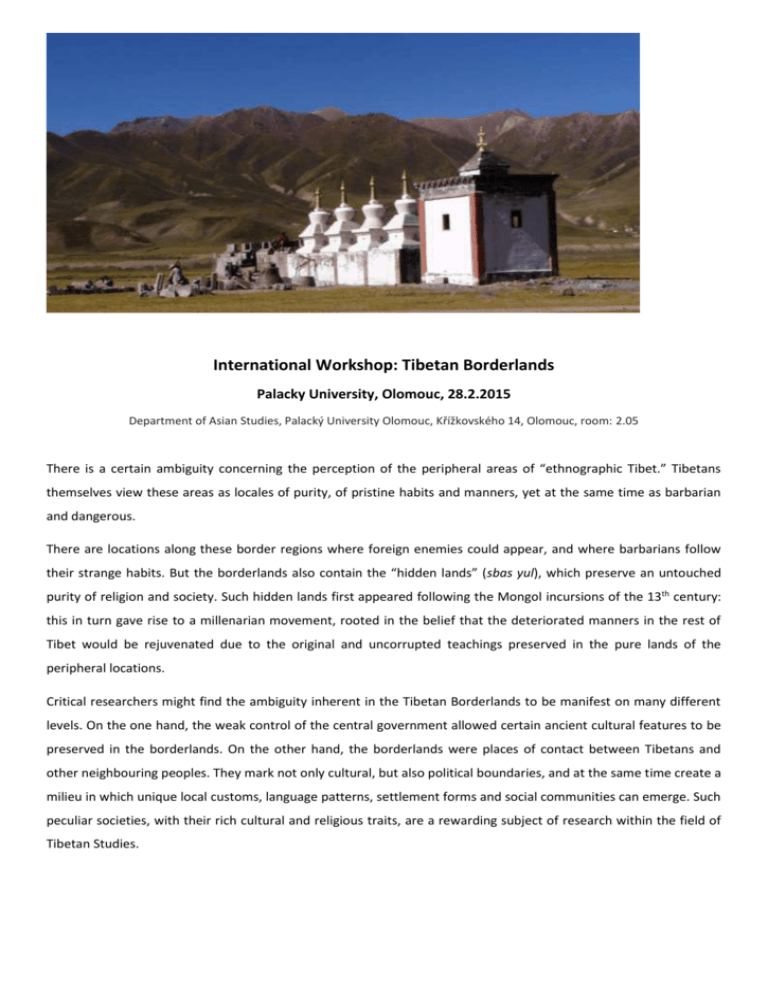
International Workshop: Tibetan Borderlands Palacky University, Olomouc, 28.2.2015 Department of Asian Studies, Palacký University Olomouc, Křížkovského 14, Olomouc, room: 2.05 There is a certain ambiguity concerning the perception of the peripheral areas of “ethnographic Tibet.” Tibetans themselves view these areas as locales of purity, of pristine habits and manners, yet at the same time as barbarian and dangerous. There are locations along these border regions where foreign enemies could appear, and where barbarians follow their strange habits. But the borderlands also contain the “hidden lands” (sbas yul), which preserve an untouched purity of religion and society. Such hidden lands first appeared following the Mongol incursions of the 13th century: this in turn gave rise to a millenarian movement, rooted in the belief that the deteriorated manners in the rest of Tibet would be rejuvenated due to the original and uncorrupted teachings preserved in the pure lands of the peripheral locations. Critical researchers might find the ambiguity inherent in the Tibetan Borderlands to be manifest on many different levels. On the one hand, the weak control of the central government allowed certain ancient cultural features to be preserved in the borderlands. On the other hand, the borderlands were places of contact between Tibetans and other neighbouring peoples. They mark not only cultural, but also political boundaries, and at the same time create a milieu in which unique local customs, language patterns, settlement forms and social communities can emerge. Such peculiar societies, with their rich cultural and religious traits, are a rewarding subject of research within the field of Tibetan Studies. Program 28.2.2015 9:00 Opening of the workshop 9:10 Gerald Kozicz (Technical University, Graz, Austria) Stupas, latos, tsatsakhangs: a preliminary report on the cultural topography of Hunder 9:40 Diana Lange (Humboldt University, Berlin) Tashilhunpo in the Nubra Valley: a preliminary report on the visual representation of cultural interactions between Tibet and Ladakh 10:10 Elliot Sperling (Indiana University, Bloomington, USA) Some notes on the history of Songpan 10:40 Coffee break 11:00 Shen Weirong (Renmin University, Beijing, China) A recently discovered early Chinese biography of dPal ldan bkra shis (14th to 15th C), a Tibetan lama from Amdo. New perspectives on the Interaction between Ming China and Tibet. 11:30 Tsering Thar (Nationalities University, Beijing, China) The inscriptions on precipices at Li wer hermitage in Gyalrong 12:00 Daniel Berounský (Charles University, Praha) Some notes on the cult of local deities in Amdo 12:30 Lunch break 13:30 Xaver Erhardt (Leipzig University, Germany) Liminal encounters: Representation of Liberation in contemporary Tibetan literature from Amdo 14:00 Jarmila Ptáčková (Oriental Institute AS, Praha) Being a Tibetan nomad in modern China. Observations from Amdo 14:30 Stevan Harrell (University of Washington) Can local ecosystems recover from Communist-led "development"? A case from a valley in Liangshan 15:00 Coffee break (Video - Interviews Stevan Harrell. 19 minutes) 15:45 Katia Buffetrille (EPHE, Paris, France) Tibetan “Borderlands” as a new center? Preliminary remarks 16:15 Charles Ramble (EPHE, Paris, France) The concepts of mtshams and mtha’: reflections on the significance of borders and margins in Tibetan religion and politics Abstracts Gerald Kozicz Stupas, latos, tsatsakhangs: A preliminary report on the cultural topography of Hunder Hunder is one of the many sites of the western Himalayas that bear witness of more than 1000 years of Buddhist traditions, but have so far almost completely escaped scholarly interest. Situated on a spur on the southern face of the Nubra Valley at the influx of a small rivulet, a former fortress or fortified village - now in ruins - allowed for the control of a trading route along the Shyok River between Skardu and the Karakorum Pass. The oldest markers of Buddhist activities in the area are rock carvings depicting bodhisattvas - as are commonly found near the bridge across the rivulet - and stupas comparable to the early 11th-12th century stupas of Shey and Nyarma. Of a more recent date are two 16th century temples within the boundaries of the ruined fort; the white painted Deachen Tsenmo and the Lhakhang Karpo, the red temple. In addition to those roughly dateable structures there are a number of lhatos and tsatsakhangs which are spread in groups all over the site. The proposed paper aims to provide a report on the lhatos and the tsatsakhangs in their local context and beyond, since one of the lhatos is directly related to another lhato in the vicinity of the nearby monastery of Dikskit. The focus will be on the interaction of the lhatos with the natural environment as well as the cross-regional spiritual network that complements the orthodox Buddhist system manifested in stupas and monastic structures. Diana Lange Tashilhunpo in the Nubra Valley: A preliminary report on the visual representation of cultural interactions between Tibet and Ladakh Currently, I am working on the British Library’s Wise Collection. The 55 ethnographic and cartographic drawings of this collection are the most comprehensive set of large-scale visual representations of mid-19th century Tibet and the Western Himalayan Kingdoms of Ladakh and Zangskar. One of the pictorial maps of the collection shows a detailed illustration of the Tashilhunpo Monastery in Southern Tibet. During a fieldwork in Ladakh in summer 2014 I I heard about three wall paintings of Tashilhunpo in the Nubra Valley. I documented two of them and realized that they are most probably older than the illustration in the Wise Collection. In my presentation I want to introduce the different illustrations and discuss their origin, style and purpose. Shen Weirong A recently discovered early Chinese biography of dPal ldan bkra shis (14th to 15th C), a Tibetan lama from Amdo. New perspectives on the interaction between Ming China and Tibet Recently an early Ming Chinese translation of the biography of dPal ldan bkra shis, a Tibetan lama from Amdo lived in 14th to 15th century, was discovered in Gansu Province, China. The biography is entitled The Record of the Origin of the Buddha Son of Western Heaven__The Precious Garland, The Adornment of Devotion of Vajrayana. It was written in 1449 by the nephew of dPal ldan bkra shis while the biographee was 69 year old and still alive. It was soon translated into Chinese and block-printed by the Ming imperial order. The block print of the biography is accompanied by painted scrolls in Ming Chinese style which vividly depicted life stories of dPal ldan bkra shis one after another. The biography is divided into seven chapters and provides great details on the political and religious activities of dPal ldan bkra shis in Tibet, China and Southern Asian lands. It also includes numerous imperial edicts and other official documents which were conferred to dPal ldan bkra shis by the Ming court. It is the earliest Chinese translation of a Tibetan lama in Ming China and also the only one of the kind so far known to us. It provides invaluable sources on almost all relevant political and religious events in both Tibet and China during that time period. It sheds especially new light on the history of rigorous political and religious interactions between Tibet and Ming China that was often neglected or denied by Tibetan historians up to date. Tsering Thar The inscriptions on precipices at Li wer hermitage in Gyalrong Several very important inscriptions on precipices are found recently at Liwer hermitage in Gyalrong, in far east of Tibet. I visited it and made a preliminary study in its dates, contents, and value. Daniel Berounský Some notes on the cult of local deities in Amdo Following the brief and general introduction of the cult of local deities in Tibet from the historical perspective the paper will offer several case-studies from the areas surrounding Labrang monastery and Ngaba town. It will attempt to show several contexts in which the cult of local deities appears in Amdo nowadays. The specifics of the cult of the local deities in Amdo are apparent in comparison with the rest of the ethnographic Tibet. However, we are still far away from answering the many questions pertaining to them. Xaver Erhard Liminal encounters: Representation of Liberation in contemporary Tibetan literature from Amdo Although mostly concealed, contemporary Tibetan literature often addresses the experiences of Tibetan’s first encounters with the People’s Liberation Army in the early 1950s. My presentation will describe such fictional representations by focusing on the literary works by the ethnic Mongol writer Tsering Döndrub from Sogpo (Qinghai). Jarmila Ptáčková Beeing a Tibetan nomad in modern China. Observations from Amdo. „When the nomads are gone, the Tibetan culture will end.“ Several Tibetan intellectuals in Amdo expressed this worry on the background of the development efforts, especially the urbanisation in western China. The nomads themselves seem to sense their engagement in the state-driven modernisation projects differently. However, are the nomads really disappearing and how far is the question of Tibetan cultural security connected to the persistence of nomadism and animal husbandry? Stevan Harrell Can local ecosystems recover from Communist-led "development"? A case from a valley in Liangshan. The Baiwu Valley in Yanyuan County, Liangshan Prefecture, was farmed sustainably at low levels for several hundred years before the founding of the People's Republic. Between 1957 and 2007, a combination of population growth and a series of failed development schemes severely degraded the environment, in a chain reaction of deforestation, soil transport, hydrological changes, and biodiversity loss. Recently, education and labor migration have reduced human pressure on the ecosystem, and a series of locally-planned restoration projects have given the system a chance to recover some of its former functioning. Although there are still environmental problems, this becomes a hopeful story of the ability of a system to heal the wounds brought by unintelligent "scientific development." Katia Buffetrille Tibetan “Borderlands” as a new center? Preliminary remarks For centuries, Central Tibet and its capital Lhasa were considered the center —as is obviously expressed in the very name of the region in Tibetan, Dbus, “Center” — of the political, religious and cultural life of the Tibetan world, the civilizing center where all Tibetans aspired to go, at least once in their lifetime. A mdo ba going to Lhasa emphasized the centralness of Lhasa by saying that “they went to Dbus”, i.e. to the Center, and A mdo pilgrims heading for Lhasa even named themselves Dbus pa “those going to the center”. In Western eyes, the Dga’ ldan pho brang state has been taken as representative of Tibet as a whole, and the creation in 1965 of the Tibet Autonomous Region geographically reduced to Central and Western Tibet shows this same Lhasa-centric perspective from the Chinese authorities. But changes seem to be occurring, raising questions about a possible shifting of the civilizing center towards outlying areas. A mdo, the northeastern region, is now the scene of a significant cultural revival, and the cradle of new expressive forms such as Tibetan film-making. At the same time, Khams and A mdo are experiencing a thriving religious revival, with famous lamas founding new religious places drawing in their vicinity huge settlements of Tibetans from all over Tibet, as well as Chinese devotees. Tourism is flourishing in Khams where Rgyal thang has been renamed Shangri la in 2002, attracting as many as 6 millions tourists in 2013, and consequently many Tibetans from A mdo and even Lhasa looking for jobs. The main sacred mountains in these Tibetan backwaters, A myes rma chen or Kha ba dkar po, used to attract only local people worshipping their yul lha are now becoming pilgrimage places for pilgrims from distant Tibetan places and even Chinese tourists. At the same time, some specific attributes of the Central province are claimed by the eastern provinces: we are seeing the (re)construction of famous religious buildings from Central Tibet in the eastern provinces, Bsam yas and Sras mkhar dgu thog in Lung sngon monastery (A mdo) for example, or the Sras mkhar dgu thog of Gtsos (A mdo) or that of Dgon gsar monastery in Khams. If the political situation explains in part the phenomenon, other factors contribute to this decentralization process. This communication will question how some Tibetan “Borderlands” are becoming a new center for Tibet. Charles Ramble The concepts of mtshams and mtha’: reflections on the significance of borders and margins in Tibetan religion and politics “Borderlands” is one of a number of terms – including “frontiers”, “margins”, “marches”, among others – that refer to closely-related, but nevertheless different, concepts. The relationship between the terms and the concepts they designate is largely a matter of convention and is likely to vary – like the respective significance of “place” and “space” – from one discipline to another. Contrary to what is often claimed about Asian polities in a pre-modern context, Tibetan societies demonstrate a very clear sense of boundaries and boundary-maintenance, with an accompanying notion of the dreadful consequences for anyone who happens to breach such boundaries—whether within the context of tantric rituals (mtshams bcad, “establishing the precincts”) or seasonal periods of village cloistering (tshos bsdams, lit. “restriction on dyeing”). In certain cases, however, we find that the mtshams (boundary) is not just a dividing line but a liminal space that offers possibilities that are not available on either side of it. This motif is present in some of the earliest Tibetan literature – for example, the generative possibilities offered by the boundary between Being and Non-being (ye/ngam, yod/med), as well as in political contexts that required the neutrality of no-man’s-land for such purposes as oath-taking. The idea of a marginal zone is more usually expressed in Tibetan by terms such as mu, mtha’ and zur (the latter term providing the etymology of the vast area of Asian uplands, straddling several nation-states, that geographers now widely refer to as “Zomia”). These margins are dangerous and cultureless (viz., without Buddhism), but they are places to which the centre can consign its essential properties for safe-keeping in times of trouble; they contain spiritual oases that represent the allocentric future (so to speak) of the civilisation. Margins are not just geographical locations, but places of power and potential that may share the same space – that is, the same geographical coordinates – with domains of order and civilisation. The “marginality” of the centre is represented most famously by the Demoness that is Tibet, a dangerous force that Srong btsan sgam po nevertheless recognised as being essential to the vitality of his empire.
